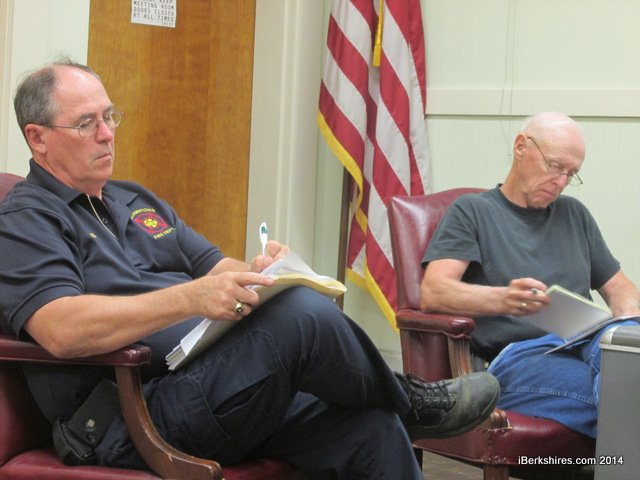Williamstown Fire District Considering Town's Overtures
 Williamstown Fire Chief Craig Pedercini, left, and Prudential Committee member Ed McGowan. Williamstown Fire Chief Craig Pedercini, left, and Prudential Committee member Ed McGowan. |
WILLIAMSTOWN, Mass. — The committee that oversees the Williamstown Fire District on Wednesday discussed a couple of opportunities to work with the town's government.
On Wednesday, Fire Chief Craig Pedercini told the Prudential Committee that he had been approached by a town employee about the possibility the district may be able to use some of the energy credits.
The district's clerk/treasurer, Corydon Thurston, said he was not sure whether the credits would help defray the cost of the district's largest electrical expense: the town's street lamps.
"Street lights are charged a flat rate," Thurston said. "They're not metered."
But the committee agreed that the prospect was worth looking into and discussing with the electric company.
The committee also did not reject out of hand a proposal to move the district's annual meeting to the same date and location as annual town meeting, but the Prudential Committee didn't express any particular urgency to do so, either.
It has been suggested that holding the two meetings on the same date would increase voters' participation in and awareness of the district, which is a completely independent municipal entity outside town government with its own taxing authority. Traditionally, the district holds its annual meeting and election of Prudential Committee members one week after annual town meeting.
Prudential Committee Chairman John Notsley said he had begun some research to see how other fire districts in the commonwealth schedule their annual meetings.
He found that in the town of Barnstable on Cape Cod, which has 8,000 voters and a fire district budget of about $10 million, 67 voters participated in the district's annual meeting.
Prudential Committee member Ed McGowan noted that Williamstown's participation rate is comparable if not higher. In 2013, 42 residents turned out for the district's election; the Williamstown Fire District has a budget of about $470,000 and about 4,600 voters.
Notsley said that while he discussed with one member of the Board of Selectmen the possibility of aligning the district's annual meeting with the town's, he was waiting for a more formal approach from the chairman of the Board of Selectmen. In the meantime, Notsley indicated the issue is not pressing.
"I've always been of the opinion the reason we don't get high attendance is ... people are very satisfied with the job being done, and the [annual budget] expense is minimal," Notsley said.
Speaking of that budget, Thurston told the Prudential Committee on Wednesday the district is on track to finish fiscal 2014 in the black.
"We haven't been audited yet, but even with some unexpected expenses, it turns out we came in fine," Thurston said. "Looking at Article V, which is the omnibus budget, there's $4,000 to spare. ... We didn't tap the reserve fund."
The district's stabilization fund, which is used to replace capital equipment (trucks) stands at $411,700 and is fully funded, Thurston said.
Thurston credited Pedercini with helping the district come in on budget despite the unexpected expenses. The district's audit is scheduled to begin on Aug. 21.
In other business on Wednesday night, the Prudential Committee heard a request from Church Street resident Shira Wohlberg to look into excessive lighting from street lamps in her neighborhood.
McGowan, who checked out the neighborhood, said he agreed with Wohlberg. The committee decided to investigate the problem further and consider either putting a hood on one of the lamps, having a lower wattage bulb installed or removing one of the lamps from the street altogether.
Tags: alternative energy, prudential committee, solar, town meeting,
 Williamstown Fire Chief Craig Pedercini, left, and Prudential Committee member Ed McGowan.
Williamstown Fire Chief Craig Pedercini, left, and Prudential Committee member Ed McGowan. Williamstown Fire Chief Craig Pedercini, left, and Prudential Committee member Ed McGowan.
Williamstown Fire Chief Craig Pedercini, left, and Prudential Committee member Ed McGowan.